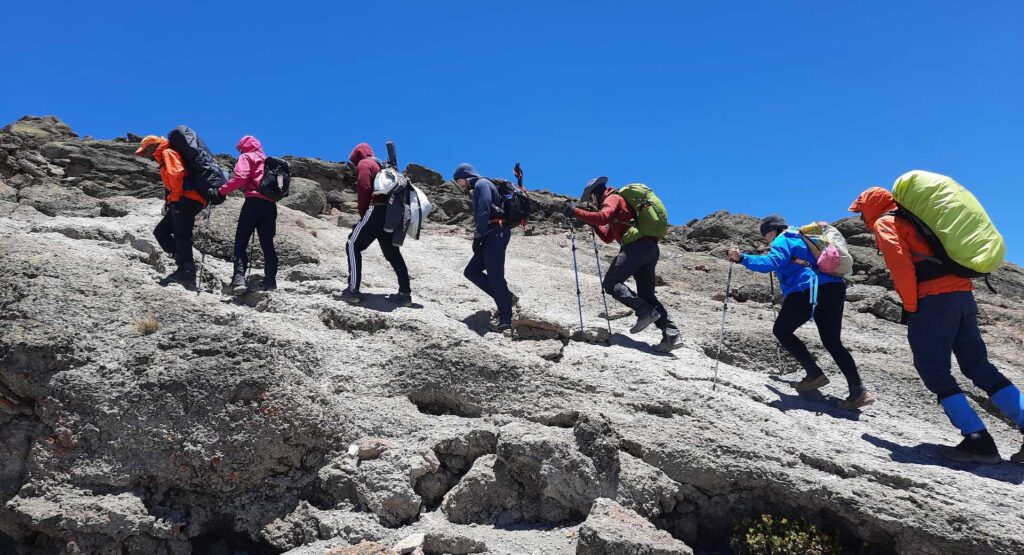- Home
- Safaris
- Hybrid tours
- Kilimanjaro
- Destinations
- Accommodations
- Travel info
- Our Company
The best time for Mount Kilimanjaro Climbing is during the dry seasons, which are from January to March and from June to October. These months offer the most favorable weather conditions for climbing, with less rainfall and clearer skies. January and February are particularly popular months for climbing because they offer the best chances for clear, unobstructed views and stable weather. The months of June to October are also good for climbing, as they are also dry and relatively warm. Avoid climbing during the rainy seasons of April, May, and November, as the trails are more slippery, and the views are often obstructed by clouds.
Mount Kilimanjaro experiences two main weather patterns: the dry season and the wet season. The dry season, from late June to October, has clear skies and less rainfall, making it the best time for climbing. The wet season, from March to May, has heavy rainfall and muddy trails, making it more challenging for climbers. January and February are another good time for climbing, with clear skies and fewer crowds. However, weather conditions can always be unpredictable, so it's essential to be prepared for any changes.
The best months for climbing Kilimanjaro are typically January, February, and September. These months offer the most stable weather conditions, with lower chances of rainfall and clearer skies. January and February are the warmest months, and September is also a great time for climbing as it's cooler and less crowded than the peak seasons. June to August are also popular months, but they tend to be busier and colder. March to May is the rainy season and not recommended for climbing due to the high precipitation, muddy trails, and limited visibility.
The off-peak seasons for climbing Kilimanjaro are from April to May and November. During these times, there is less foot traffic on the mountain, which means you can enjoy a quieter and more exclusive experience. However, it's important to be aware that the weather can be more unpredictable during these months, with a higher chance of rain and colder temperatures. It's also worth noting that some routes, such as the Northern Circuit and Lemosho, are less affected by the weather changes and are good options to consider during the off-peak seasons.

Peak season for climbing Kilimanjaro typically falls between January and March and June to October. During these months, the weather is milder and more stable, making it easier to trek. With clearer skies, you also have a better chance of enjoying the stunning views from the summit. However, the downside is that the mountain can be quite crowded during these months, which may affect the overall experience. Additionally, prices for tours and accommodations are usually higher during peak season.
When planning your Kilimanjaro climbing trip, it's crucial to find the right tour operator. Here are a few key points to consider when selecting a tour operator:
Peak climbing seasons for Mount Kilimanjaro are typically from January to March and June to October. These periods offer the best weather conditions and the highest success rates for summiting. January and February are particularly popular due to the clear skies and less precipitation. During peak season, the routes tend to be busier, but you'll benefit from optimal climbing conditions and breathtaking views. If you're considering planning your trip during these periods, it's advisable to book your climb and accommodations well in advance to secure your spot.

If you're planning to climb Kilimanjaro during the off-peak season, be prepared for colder weather and more unpredictable conditions. The off-peak climbing months of April, May, and November generally have fewer tourists, lower prices, and quieter trails. However, it's important to pack and dress accordingly for the colder temperatures, potential rainfall, and less predictable weather patterns. Make sure to bring appropriate cold-weather gear, waterproof clothing, sturdy hiking boots, and sufficient layers to stay warm and dry during your climb. Keep in mind that the off-peak season may offer a more solitary experience, but it's essential to be well-prepared for the potentially challenging weather conditions.
Make sure to bring the following gear essentials for your Kilimanjaro climbing trip:
After considering all the factors, the best time to climb Kilimanjaro is during the dry season, from June to October. This period offers the most favorable weather condition, the clearest visibility, and the highest success rates for summiting. Additionally, it's important to choose a reputable tour operator and ensure that they provide adequate acclimatization days to increase your chances of reaching the top. If you’re looking to avoid the crowds, consider scheduling your trek for the quieter months of November or March. Lastly, remember to take the necessary precautions and stay hydrated throughout the climb.